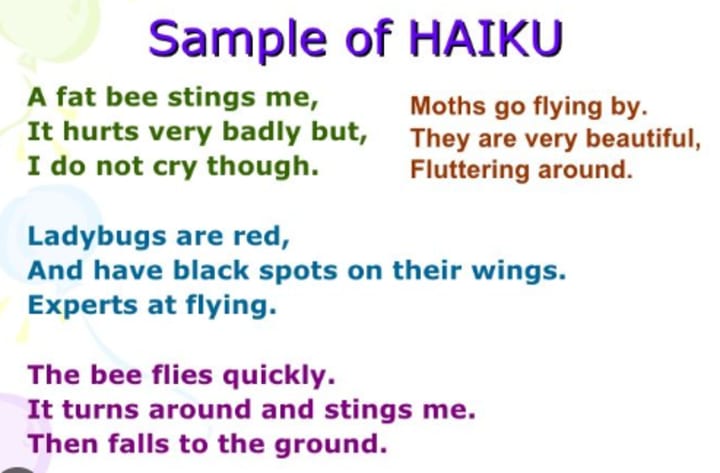how to write a haiku
Crafting Poetry: Advice, Tips, and Techniques for Aspiring Poets

Haiku, a traditional form of Japanese poetry, has captivated readers around the world with its simplicity, elegance, and ability to evoke vivid imagery and emotions in just a few short lines. While haiku may appear deceptively simple, mastering this ancient art form requires careful attention to structure, language, and imagery. In this comprehensive guide, we'll explore the essential elements of haiku and provide step-by-step instructions on how to write your own haiku poems.

Understanding the Structure of Haiku:
Haiku is a form of short poetry that originated in Japan, typically consisting of three lines with a syllable pattern of 5-7-5. This strict structure imposes brevity and encourages poets to distill their thoughts and observations into a concise and evocative form. While traditional haiku often focus on nature and the changing seasons, modern haiku may explore a wide range of themes and subjects.
Step-by-Step Guide to Writing Haiku:
Choose a Theme or Subject:
Begin by selecting a theme or subject for your haiku. Traditional haiku often depict scenes from nature, such as landscapes, seasons, or natural phenomena. However, modern haiku may explore a variety of topics, including human emotions, everyday experiences, or fleeting moments of beauty.
Focus on Observation:
Haiku is known for its emphasis on sensory observation and attention to detail. Take time to observe your surroundings closely, paying attention to sights, sounds, smells, and sensations. Look for moments of beauty, simplicity, or significance that can serve as the inspiration for your haiku.
Craft the Language:
Once you have chosen a theme and observed your subject closely, begin crafting the language of your haiku. Aim for simplicity, using clear and concise language to convey your message or evoke a mood. Select words that evoke strong imagery and sensory impressions, avoiding unnecessary adjectives or embellishments.
Follow the Syllable Pattern:
Haiku traditionally follows a syllable pattern of 5-7-5, with five syllables in the first line, seven syllables in the second line, and five syllables in the third line. Pay careful attention to syllable count as you compose your haiku, using words and phrases that fit within the constraints of the form while maintaining clarity and meaning.
Capture the Essence:
Haiku is often described as a "snapshot" or "moment in time," capturing a single moment or observation in just a few short lines. Focus on capturing the essence of your subject or theme, conveying a sense of mood, atmosphere, or emotion that resonates with the reader.
Revise and Refine:
Once you have written your haiku, take time to revise and refine your poem. Read it aloud to yourself, paying attention to the rhythm, flow, and imagery. Make any necessary adjustments to improve clarity, coherence, or impact, and consider experimenting with different words or phrases to enhance the poem's effectiveness.
Embrace Imperfection:
Haiku is a form of poetry that celebrates simplicity, spontaneity, and imperfection. Don't be discouraged if your first attempts at writing haiku are not perfect. Embrace the process of experimentation and discovery, and allow yourself the freedom to make mistakes and learn from them as you continue to explore the art of haiku.
Writing haiku is a rewarding and meditative practice that encourages poets to slow down, observe the world around them, and distill their experiences into moments of beauty and insight. By following these steps and guidelines, you can begin to master the art of haiku and create poems that resonate with readers and evoke the timeless beauty of this ancient poetic form. Whether you're capturing the changing seasons, reflecting on the passage of time, or simply savoring a quiet moment of contemplation, haiku offers a powerful and evocative means of expressing the essence of the human experience in just a few short lines.
Embrace Your Authentic Voice:
At the heart of every poem lies the unique voice and perspective of the poet. Embrace your individuality, experiences, and emotions, and allow them to shape your poetry in meaningful ways. Don't be afraid to write from the heart and to explore themes and subjects that resonate with you personally.
Read Widely and Deeply:
One of the best ways to improve your own poetry is to read the work of other poets. Explore a diverse range of poetry, including classic and contemporary works, as well as different styles, forms, and traditions. Pay attention to how poets use language, imagery, and structure to convey emotion and meaning, and take inspiration from their techniques in your own writing.
Experiment with Form and Structure:
Poetry comes in many forms, from traditional sonnets and villanelles to free verse and experimental poetry. Experiment with different forms, meters, rhyme schemes, and structures to find the ones that best suit your style and subject matter. Don't be afraid to break the rules or to invent your own forms if it serves your artistic vision.
Show, Don't Tell:
One of the cardinal rules of poetry is to show rather than tell. Use vivid imagery, sensory details, and figurative language to evoke emotions and create powerful mental images in the minds of your readers. Invite your readers to experience the emotions and themes of your poetry through their own interpretation.
Use Sound and Rhythm:
Pay attention to the musicality of your poetry, using techniques such as alliteration, assonance, consonance, and onomatopoeia to create rhythm, texture, and emphasis. Read your poems aloud to hear how they sound, and make adjustments as needed to enhance their musicality and flow.
Edit and Revise:
Writing poetry is a process of discovery and refinement. Don't be afraid to revise your poems multiple times, experimenting with different word choices, line breaks, and stanza lengths until you're satisfied with the final result. Seek feedback from trusted readers or fellow poets to gain fresh perspectives on your work and to identify areas for improvement.
Write with Intention:
Every word, line, and stanza in your poem should serve a purpose. Be intentional in your choices, considering the effect and impact of each element on the overall meaning and theme of your poem. Remove any unnecessary words or phrases that don't contribute to the clarity or depth of your poetry, and strive for precision and economy of language.
Find Inspiration in Everyday Life:
Poetry can be found in the ordinary moments and experiences of everyday life. Pay attention to the world around you, finding inspiration in nature, relationships, emotions, and the human condition. Keep a journal or notebook to capture ideas, observations, and snippets of language that spark your creativity and serve as fodder for your poetry.
Be Open to Feedback and Growth:
Writing poetry is a journey of growth and self-discovery. Be open to feedback from others, and don't be afraid to seek out constructive criticism to help you improve your craft. Join writing groups or workshops, attend poetry readings and events, and connect with other poets to share ideas, learn from each other, and grow as writers.
Practice Patience and Perseverance:
Writing poetry is not always easy, and success often requires patience, perseverance, and dedication. Be prepared to put in the time and effort to hone your craft, and don't be discouraged by setbacks or challenges along the way. Trust in your own voice and vision, and keep writing, revising, and refining your poetry until you achieve the results you desire.
Conclusion:
Writing poetry is a deeply personal and rewarding journey that offers endless opportunities for self-expression, creativity, and growth. By embracing your authentic voice, reading widely, experimenting with form and structure, and honing your craft through practice and revision, you can bring your poetic vision to life and share it with the world. Whether you're writing a haiku, a sonnet, or a free verse poem, remember to trust in your own creativity and to let your passion for poetry guide you on your journey.
About the Creator
JOSIAH NWOKO
Enchanting Stories: Embark on unforgettable journeys to fantastical worlds and alternate realities with my enchanting stories, where dreams come alive and anything is possible Join me on a literary adventure. #Writer #Poet #Storyteller
Reader insights
Nice work
Very well written. Keep up the good work!
Top insights
Easy to read and follow
Well-structured & engaging content
On-point and relevant
Writing reflected the title & theme






Comments (3)
Thank you for posting about Haiku. You've inspired me to return to that format once again and I'm really enjoying it!
informative.
Excellent how to for crafting a Haiku specifically and poetry more generally!